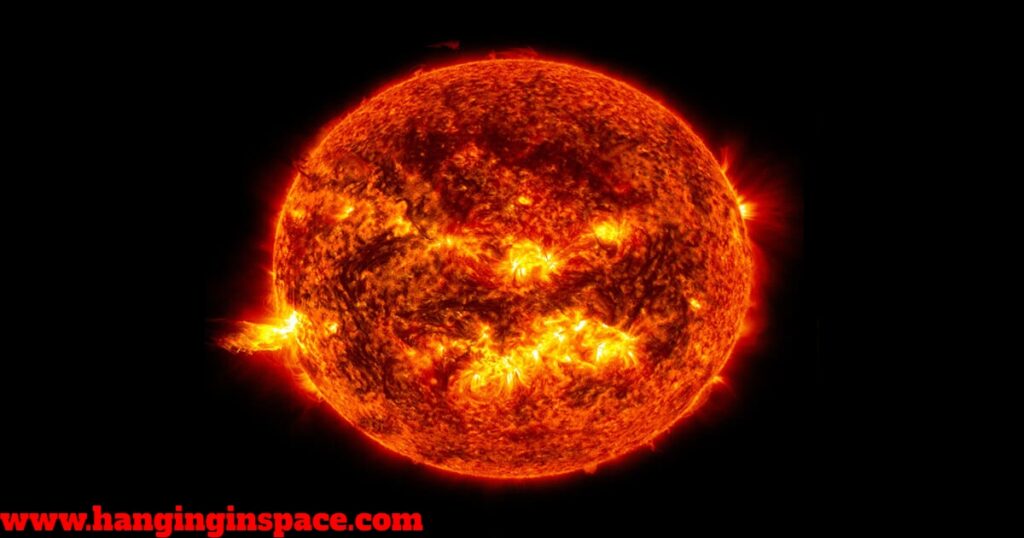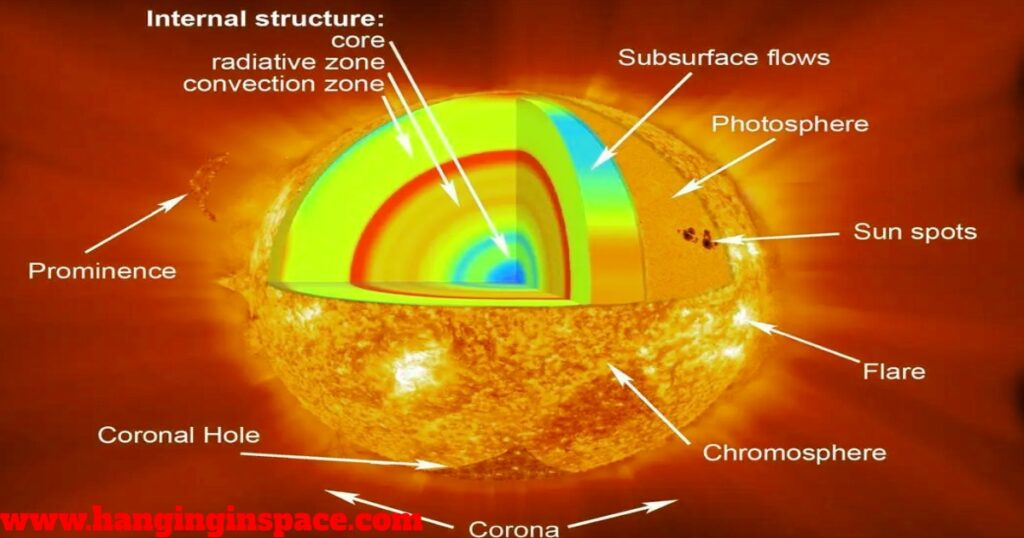The Sun is a giant ball of hot plasma at the heart of our solar system. The Sun is mainly composed of hydrogen and helium, and it powers itself through nuclear fusion, producing the light and heat that sustain life on Earth.

Sun’s Life Cycle:
About 4.6 billion years ago, the Sun was born from a giant cloud of gas and dust collapsing under its own gravity. During this time, it was a hot, swirling mass. Our Sun is currently in its middle age, fusing hydrogen in its core and keeping us warm.
At an estimated age of 4.6 billion years, it has at least another 5 billion years before it transitions into a white dwarf. Our Solar system will be transformed dramatically when the Sun will turn into a white dwarf.
What is the Size of the Sun?
The Sun’s radius is approximately 696,340 kilometers (432,690 miles). The Sun’s diameter is about 1,391,000 kilometers (864,000 miles). The Sun’s circumference is roughly 4,366,813 kilometers (2,715,395 miles).
If you could fit all the planets in our solar system inside the sun, there would still be plenty of room to spare.
What is the Mass and Volume of the Sun?
The Sun’s mass is approximately 1.989 x 10^30 kilograms (kg). The volume of the sun is approximately 1.41 x 10^18 cubic kilometers (km³). The sun’s volume is a staggering 1.3 million times greater than Earth’s.
What is the Temperature of the Sun?
The temperature of the sun’s surface, known as the photosphere, is approximately 5,500 degrees Celsius (9,932 degrees Fahrenheit). However, temperatures increase dramatically towards the sun’s core, reaching millions of degrees Celsius.
What is Sun’s Average Distance from Earth?
The average distance from Earth to the Sun, also known as 1 astronomical unit (AU), is approximately 149.6 million kilometers (about 93 million miles).
How long does it take the Sun to Spin on its Axis?
The Sun’s rotation isn’t quite as straightforward as a planet’s because it’s a giant ball of gas and plasma. Unlike a solid planet, the Sun rotates at different speeds at different latitudes. The material at the Sun’s equator rotates faster than the material at its poles.
Sun’s Equator: The Sun’s equator rotates the fastest, taking approximately 24.47 days to complete one full rotation.
Sun’s Poles: The material at the Sun’s poles rotates significantly slower, taking nearly 35 days to complete one rotation.
Gravitational Field Strength:
The Sun’s surface gravity is approximately 274 m/s². This is about 28 times stronger than the gravity we experience on Earth (which is approximately 9.81 m/s²).
Escape Velocity:
The escape velocity to leave the gravitational pull of the Sun is approximately 617.5 kilometers per second (km/s).
What is the Composition of the Sun?
The Sun is a star, a massive ball of hot plasma, primarily composed of hydrogen (about 73%) and helium (around 25%). Plasma, often referred to as the fourth state of matter, is a superheated gas where electrons are stripped away from atoms, creating a sea of charged particles.
What is the Interior Structure of the Sun?
The sun’s interior structure consists of the core, radiative zone, and convective zone.
Core:
Occupying roughly 25% of the sun’s radius, the core is the heart of the star where magic happens. Here, under immense pressure and temperatures exceeding 15 million degrees Celsius (27 million degrees Fahrenheit), hydrogen atoms undergo nuclear fusion. This process, known as a proton-proton chain reaction, converts hydrogen into helium, releasing tremendous energy in the form of light and heat. This energy is the powerhouse that drives the sun’s activity and ultimately sustains life on Earth.
Radiative Zone:
Enveloping the core is the radiative zone, which extends outwards for about 70% of the sun’s radius. In this region, the intense heat generated in the core is too strong for direct convection currents to transport it outward. Instead, energy is transferred through radiation.
Photons (particles of light) bounce and interact with densely packed matter, slowly diffusing outward and carrying the heat from the core toward the surface. This process is incredibly inefficient, taking millions of years for a single photon to reach the sun’s outer layers.
Convective Zone:
Occupying the outermost 30% of the sun’s radius lies the convective zone. Here, the temperature drops significantly compared to the core and radiative zone. The hot, less dense plasma near the surface rises, while cooler, denser plasma sinks, forming a massive circulation pattern.
These convection currents are like giant bubbles of hot plasma churning their way upward, carrying heat toward the sun’s surface. Once they reach the surface, they cool down, sink back down, and the cycle continues. This churning motion is responsible for many of the features we see on the sun’s surface, such as granulation and sunspots.

What does the Atmosphere of the Sun consist of?
Here’s a breakdown of the sun’s atmospheric layers, starting from the closest to the sun and moving outwards:
Photosphere:
This is the innermost layer, the visible surface of the sun, that we see. It’s from here that light and energy, including sunlight, are emitted. The photosphere is a turbulent region with features like sunspots and solar flares.
Chromosphere:
This layer lies just above the photosphere and is visible during a total solar eclipse. It appears as a thin red ring around the black disc of the eclipsed Sun. The chromosphere is where spicules, jets of hot gas, erupt from the Sun’s surface.
Transition Region:
This is a very thin layer between the chromosphere and the corona. It’s where the temperature rapidly increases, and the gas becomes much hotter and more tenuous.
Corona:
The outermost layer of the Sun’s atmosphere extends millions of kilometers into space. The corona is extremely hot, with temperatures exceeding millions of degrees Celsius. It’s visible during a solar eclipse as a faint white halo surrounding the eclipsed Sun.
The corona is also the source of the solar wind, a stream of charged particles constantly flowing outwards from the Sun.
The Sun’s atmosphere is composed primarily of hydrogen and helium, just like the Sun itself. However, there are also trace amounts of other elements present, such as oxygen, carbon, and iron.
Sun’s Dynamic Nature:
The Sun’s surface is constantly in motion, with solar flares and prominences erupting from time to time. Solar flares are intense bursts of energy that can release enormous amounts of radiation.
Prominences are giant loops of hot plasma that erupt from the Sun’s surface and can sometimes be seen with the naked eye during a solar eclipse. These solar storms can have a significant impact on Earth, disrupting communication systems and even causing power outages.
The sun also exhibits a phenomenon known as the solar cycle, in which the sun’s magnetic field passes through and lasts for about eleven years. During a solar maximum, the sun’s surface is more active, with an increased frequency of solar flares and prominences.
Conversely, a solar minimum is a period of relative calm. Understanding the solar cycle is crucial for predicting and mitigating the effects of solar storms on Earth’s technology and infrastructure.

What is the Sun’s Influence?
The sun’s impact on Earth goes far beyond simply providing light and heat. Its gravity holds our solar system together, keeping the planets in their orbits. The sun’s radiation also drives Earth’s weather patterns, influencing everything from wind currents to ocean circulation.
But the sun’s influence extends beyond the physical. Photosynthesis, the process by which plants convert sunlight into energy, is the foundation of life on Earth. Without the sun’s constant stream of photons, life as we know it wouldn’t exist.
Sun’s Formation:
The Sun formed about 4.6 billion years ago from a vast cloud of gas and dust known as a molecular cloud. The process began when gravitational forces caused the cloud to collapse, leading to the formation of a protostar at its center.
As the protostar continued to accrete more material, its core temperature increased, triggering nuclear fusion reactions that released immense amounts of energy.
This fusion process generates the sun’s heat and light, transforming it into a stable, main-sequence star. The leftover material from the sun’s formation eventually coalesced to form the planets, moons, and other objects in the solar system. Today, the sun continues to shine as the central and most significant source of light and energy in our solar system.
When and Who Discovered the Sun?
The discovery of the sun is not attributed to a single individual, as it has been known since prehistoric times. Early civilizations, such as the ancient Egyptians and Greeks, worshipped the sun as a deity and recognized its importance for life on Earth.
Ancient astronomers like Ptolemy and Aristarchus made significant contributions to understanding the sun’s motions and its central role in the solar system.
However, it was not until the advent of modern astronomy and the development of telescopes in the 17th century that scientists began to study the sun’s surface and features in more detail. Today, we continue to explore and study the Sun using advanced technology and space missions, deepening our understanding of this essential star and its influence on our planet.
Conclusion:
The Sun is a middle-aged star, about halfway through its estimated lifespan of 10 billion years. It will continue to shine steadily for billions of years to come, providing a nurturing environment for life on Earth.
